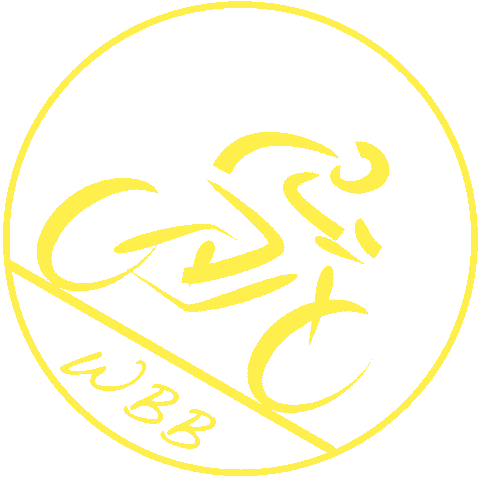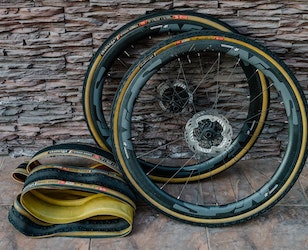
Tires - Be Faster, Safer, More Comfortable
You can have it all with wider tires
In cycling, “contact points” are critical: bum on saddle, hands on handlebars, feet on pedals. But the most important one of all is “where the rubber meets the road”. Tires may be the most important component on your bike. The right tire at the right pressure makes a huge difference to your safety - your “grip” on the road - as well as to your comfort, and efficiency.
Diving into detail on tires, with a focus on tire width, tire pressure, and tire quality, we will discover:
- Wider tires are just as fast as narrow ones, but safer and more comfortable
- Tire pressure doesn’t matter too much on smooth roads, on rough roads lower pressures are more efficient
- Tire quality, specifically the suppleness of the casing matters a lot
Note: I’ve included a list of references and background reading at the end of this article.
Tire Performance Laid Bare
Last spring, I took my new Niner RLT 9 “adventure” gravel bike out for a spin off-road in Gatineau Park. My Niner is “built for comfort not for speed” - durable aluminum frame, long wheelbase, wide rimmed wheels, 40mm tires at a pressure of 40psi. After cycling some rough trails, I headed back on the pavement from Champlain Lookout. On the Parkway, for fun, I “opened it up” attacking the descent of Fortune Lake Parkway from the “T” intersection to Meech Lake Road. I found the descent fun and easy - the bike felt stable and sure-footed.
But here’s the thing - Strava recorded my fastest ever descent of Fortune Lake! Faster than on my carbon fibre race bike, with its race wheels and 25mm tires at 90psi. What gives?
Misconception: Narrower and Higher Pressure is Faster
There are two main components of tire rolling resistance:
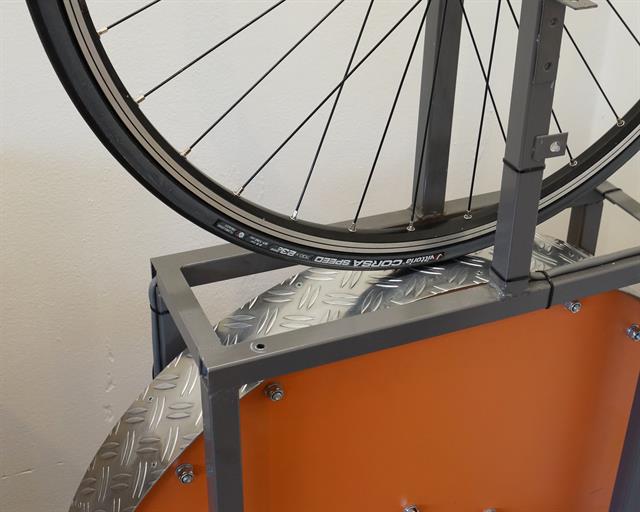
Naive Tire Testing Rig
Energy is absorbed in the tire as it flexes and makes contact with the road (hysteretic losses) This is measured as the “coefficient of rolling resistance” (Crr). Crr ignores the road surface and the weight of the rider. It’s measured by rolling a tire on a smooth metal drum. Narrower tires at the highest pressure possible will have the lowest Crr. For riding a smooth indoor velodrome, 23mm tires pumped up to 160psi are ideal. The photo on the right shows a typical Crr measuring rig.
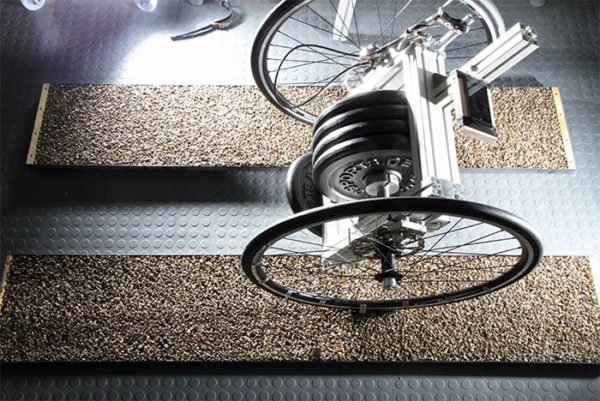
Better Tire Testing Rig
Energy absorbed by the vibration of the rider and bike (suspension or impedance losses) This is the energy that “rattles” a rider and bike up and down on uneven road surfaces. It’s an energy loss that slows you down just like aerodynamic drag or any other energy loss. This component of rolling resistance is affected by the road surface and rider weight. And it turns out on typical road surfaces this component dwarfs Crr - we’ve been measuring “rolling resistance” incorrectly! We really need something like the measuring rig shown on the right.
When Crr and Suspension Losses are combined, a graph of total rolling resistance vs tire pressure (for a given tire type/width) for different road surfaces ends up looking like the chart below:
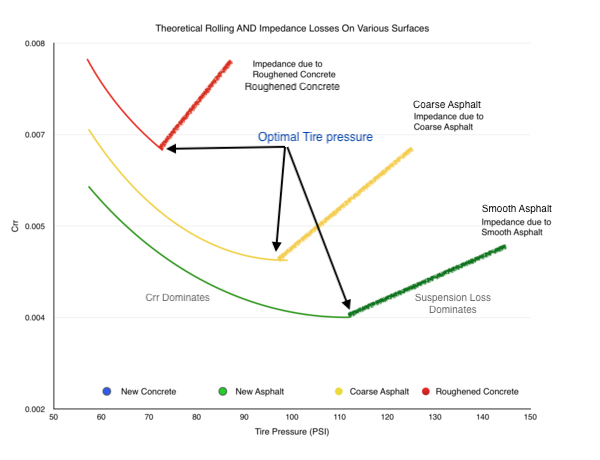
Total Resistance Graph
Notice:
- For a given road surface there is an optimal tire pressure. Pumping up your tires too much results in higher rolling resistance and a less comfortable ride.
- The optimal tire pressure drops as the road surface gets rougher
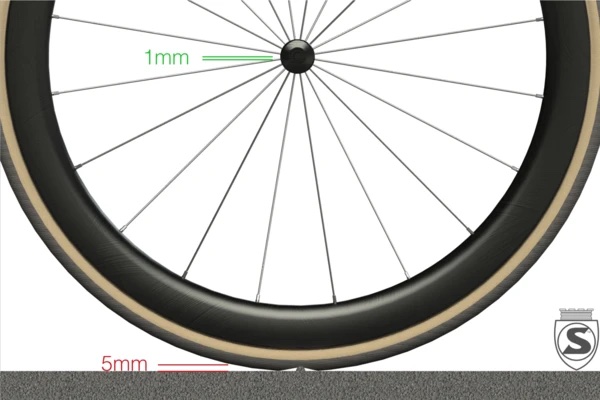
Rolling Tire Illustration
That’s why we invented pneumatic tires - the air in the tire absorbs irregularities on the road and reduces the suspension losses, the “rattling” that steals energy. Let’s think about this intuitively - imagine rolling over a 5mm bump on the road as shown on the right.
The tire deforms to go over the bump, so you and the bike don’t “rattle” as much, reducing the suspension losses. The bigger the bumps, the more we would like the tire to be able to deform. So, we want lower pressure on rougher roads. And wider tires can be run at a lower pressure, giving us a speed advantage on typical paved road surfaces, and “win big” on rough roads. But there’s more!
Safety, Comfort, and Speed - Wider is Better
- Notice how the tire stays in better contact with the road! Wider tires at lower pressure have better “dynamic grip”. They are much more tolerant of road imperfections and loose dirt on the road. A narrow tire at high pressure will tend to “bounce”, and small imperfections on the road will significantly reduce its contact, make it more prone to slipping, and you to crashing!
- Reducing the suspension losses reduces the “rattling” vibration of the bike and rider. They absorb bumps and irregularities in the road surface. You can be more comfortable which allows you to ride longer with less fatigue!
- Wider tires at lower pressure perform much better on wet roads, are much less likely to slip in the wet
- They don’t get caught in narrow cracks, or in the tar “snakes” that go soft in the summer heat.
- They handle railway tracks, potholes and other road hazards more easily.
- They run much better on gravel roads.
OK, So What Tire Size Should I Use?
Simply put, as the roads get rougher, your tires need to be wider for optimal performance, safety, and comfort. Yeah, but taken to extremes our arguments break down… wheels and tires do get too heavy, wide and “sloppy”. So for recreational riders like us, what’s the “sweet spot”?
What do the pros ride?
Looking at the World Tour professional road racers use will give us a good handle on the minimum size of tire we should be using:
- World Tour teams use 26mm to 28mm tires for general road racing on good roads. And the trend in the last year has been to 28mm (eg. Julian Alaphilippe rode 26mm tubed clinchers when winning the World Championships in 2020, and the EF Pro Cycling moved to 28mm in 2022
- On rougher roads they will go from 28mm to 32mm. (eg. Kasper Asgreen won the 2021 Tour of Flanders on 28mm tubed clinchers)
- On rougher, cobbled races, some riders will go up to 32mm tires (eg. for the Paris Roubaix)
So that’s a minimum, if you are averaging 40kph and up and want to squeeze the last drop of performance at the cost of comfort and safety. What about us mere mortals?
What do the “Experts” Ride?
By “experts”, I mean the high-end sportif enthusiasts, who are competing in events, riding hundreds of kilometres a week and keep current on cycling technology.
There’s a pretty strong consensus that for general purpose road riding on the sorts of roads we have in the National Capital Region, tires in the range of 32mm-35mm are ideal. For mixed-surface gravel riding, 38mm-40mm is the common wisdom. For rough, unmaintained roads, its the maximum you can fit on your bike (around 48-55mm for gravel bikes). But really, the best answer is: “The widest tires 32mm or larger that you can fit on your bike!”
The Bottom Line
If you want to be safe, comfortable and fast:
- If you can’t fit at least 28mm tires on your bike, you need to buy new bike!
- If you can, you should be using at least 32mm tires
- If you are looking for a new bike, you bike must have clearances for 35mm tires as an absolute minimum. 40mm is preferable.
Tires smaller than 25mm are only suitable for the best velodromes, where the suspension/impedance losses are essentially zero. At the Pan Am Games velodrome in Milton, we use 21-23mm tires, pumped up as high as the tire will allow. (I use a 23mm tire pumped up to 130psi)
What Tire Pressure Should I Use?
- First, and most importantly, the pressure numbers on the side of your tire are next to useless. You can effectively ignore them.
- And remember, as the road gets rougher, the optimal tire pressure for minimum rolling resistance goes down.
- There is a minimum pressure, based on the tire width and weight, but it’s lower than you probably think!
There are three main criteria that go into determining the correct tire pressure to use:
- The total weight held up by the wheels (your weight + bike weight + what you are carrying) -> More weight, more pressure needed
- The tire width -> Wider tires, less pressure needed
- The road surface you expect to be travelling on. (When in doubt, you base your tire pressure on the roughest surface you expect to ride) -> Rougher roads, less pressure
Use a tire pressure calculator to determine what pressure is right for you. Different calculators will give different results. Ones that I’m partial to are:
- SILCA Professional Pressure Calculator
- Fast Fitness Tips Tyre Pressure Calculator Google Sheet
- SRAM | AXS [Really a mountain bike calculator, but works for road and gravel too]
On road bikes, the front tire has less weight on it than the rear, so it uses a lower pressure than the rear. Below is my my calculated tire pressures for a wide range of tire widths and riding conditions. The smallest tire I use outdoors is 32mm, so the 25mm and 28mm rows are for example only. Each entry shows the front/rear pressure for a given tire width and road surface, given my total riding weight of 102kg. For example, I’d use a pressure of 60psi on the front and 65psi on the rear when on a typical paved road ride with my 32mm tires. But when I head into Marlborough Forest on my 42mm tires, I’d be down to 30psi on the front and 34psi on the rear.
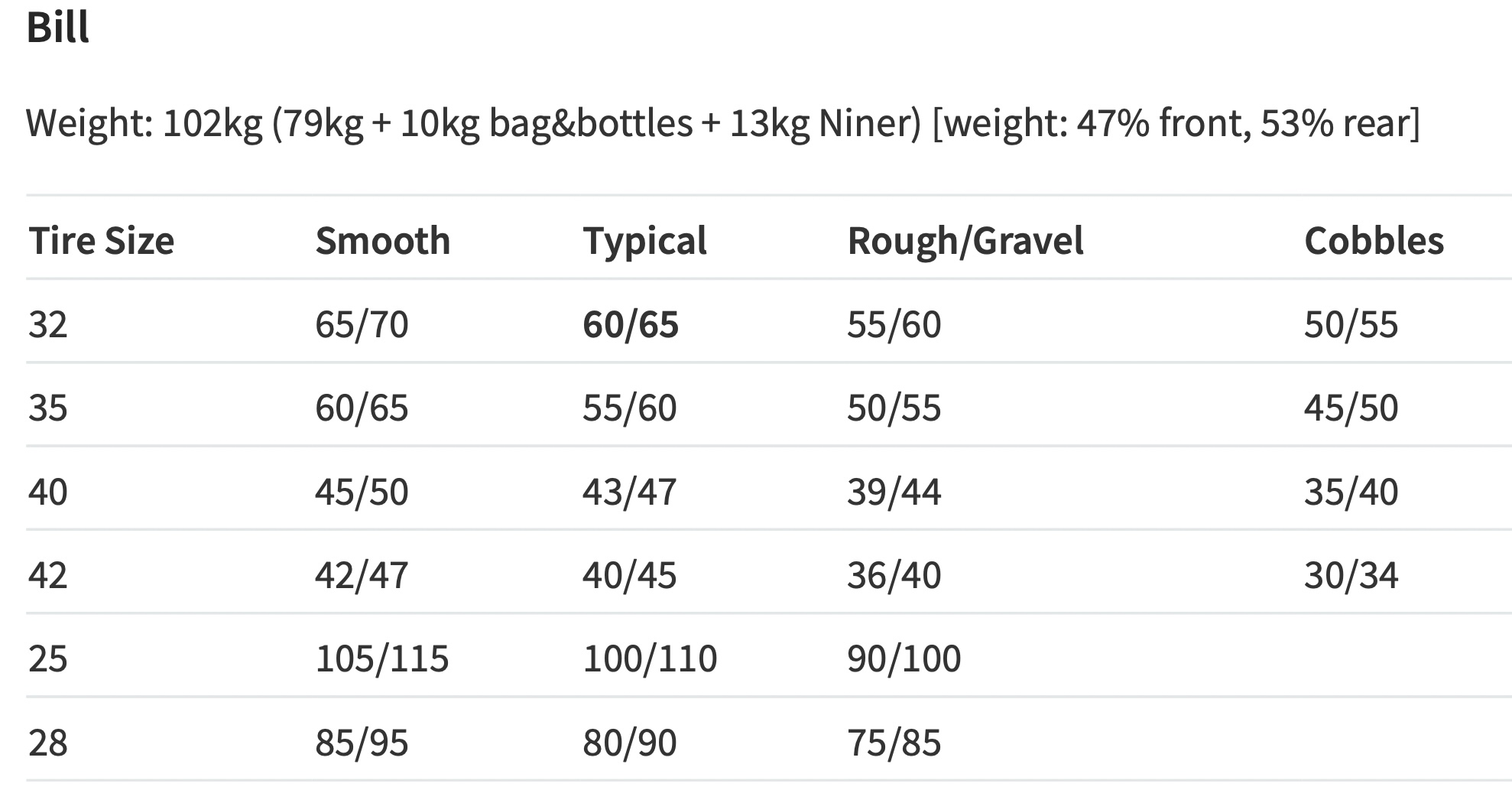
Tire Pressures I Use
What Type of Tire is Best?
OK, the last subject… what makes a good tire? Given we want a tire that deforms with a minimum of energy loss, “supple” is the name of the game. Supple tires have a very high quality tire casing, with a high thread count. (120 TPI and greater) And that makes them expensive. But it’s worth it, the ride feel of a high-quality, supple tire is quite noticeable.
Besides cost, the other tradeoff is durability. The most supple tires have a little less puncture resistance, especially in the sidewalls. But unless you are heading off on an epic bike packing adventure on rough roads, the tradeoff is well worth it. And even the sleekest, most supple quality tire will last a full riding season (say 5,000 KM)
What about the tread pattern? Modern tire compounds make significant tread patterns unnecessary for most riding. You will get the best ride using “slick” tires, or ones with a very subtle “file tread” pattern. Experienced gravel riders use wide (38mm and wider) file tread tires for most of their riding. A significant tread pattern is only necessary when riding in deep, soft materials like mud, sand, and snow, or when riding at very low speeds on rough ground where you make extreme steering actions (think mountain biking or bike packing on rough roads).
For example, my “go to” tires for road riding are:
- the Continental GP5000 32mm tire for my wife
- the René Herse 35mm Bon Jon Pass Extralight for myself. Their extra-light casing file treads are amazing and I love them. But their prices are hard to swallow.
Other manufacturers have similar great tires… but you are in the $90 per tire range.
Background and References
The Downside … bike handling
Going wider wins on comfort, safety, and speed. There is one downside… bike handling. The extra angular momentum of heavier rims and tires doesn’t affect your speed, but it does have a small effect on the steering. The steering will feel a little sluggish, especially at high speed. This matters to competitive cyclists who have to negotiate tight corners at 50kph and maneuver in a tight pack. But for us mere mortals, it won’t actually affect our riding.
Other Misconceptions:
But narrow tires and rims are more aero right? Less frontal area. Nope! Another misconception. If you take a simple narrow rim, with a narrow tire and place it in a straight headwind, all other things being equal, narrow wins. But we almost never ride directly into the wind! Most of the time the combination of our forward motion and wind direction means the wheel has bit of a “cross wind” on it (This is referred to as the “yaw angle”). Also, modern materials and manufacturing techniques now allow us to create streamlined rim shapes. This ability to “shape” the rim, means the profile shape of the tire and rim combination matters a lot, and it turns out wider rim sections actually allow for better aerodynamics. (Of course this argument breaks down as rims and tires get really wide, say beyond 40mm, and at higher speeds, say 40kph and up)
But really, the aerodynamic losses from wheels is quite small compared to your position on the bike, your clothing, and your helmet. (If you care about aero, see Biggest Bang For Your Buck In Time Trial Equipment - CyclingTips, Buying Time: Which Aero Equipment Offers the Most Benefits? and Cycling Aerodynamics Time Savings: What Really Works, with Chart )
But lighter wheels/tires are better, because extra rotating mass slows you down, and is harder to accelerate. Nope! First, once the mass is moving or rotating, its effect on speed and effort is zero. Second, you can do the high-school physics math… the mass of rims and tires compared your your body weight and that of the bike is so small that the extra power needed to accelerate the wheel is so small as to make essentially no difference. (For more information see Will Lighter Wheels Make You Faster When Cycling)
Cargo Cults and Placebo Effects
The slight change in bike handling and the more comfortable ride makes us “feel” that wider tires result in a slower bike, even though that’s not the case. We are misinterpreting the cues the bike is giving us. Besides, we “know” that lighter, skinnier wheels are better… “everyone” knows that!
Welcome to the complex world of misconceptions in cycling technology! We repeat erroneous ideas until they become “common knowledge”. We perform testing improperly, or not all. We make invalid assumptions. Jan Heine’s summary at Myths in Cycling (1): Wider Tires Are Slower – Rene Herse Cycles is a good read on why it took us so long to move back to wider tires on bikes.
Josh Poertner, the former head of R&D at Zipp Wheels, and the current owner of Silca, who has spent years studying cycling wheels and tires and working with many pro teams to optimize their equipment states:
I have often seen in testing that if a rider believes something to be true, he_she will very often ‘feel’ that in the test ride, particularly if the effect in question is relatively small. The placebo effect is very strong in cycling…
Cargo Cults are when we imitate behaviours without understanding how they work in the hope of achieving the same results. It’s common in cycling. Placebo Effects occur when our belief in something creates a real, positive, physical response.
Josh and his colleagues has produced a couple of podcasts on the topic. If you are interested in cycling technology, these are “must listen” shows - informative, and very entertaining.
- Podcasts – Marginal Gains Podcast
- Granola and Cargo Cults – Marginal Gains Podcast
- The Placebo Effect and Marginal Gains – Marginal Gains Podcast - Has a great story on how Josh used a placebo to make Lance Armstrong and the US Postal Team happy with their Zipp disc wheels, and help them win the Tour de France!
All About Tire Width and Pressure Optimization
These sources provide a comprehensive discussion of the topic, written by acknowledged experts:
Jan Heine at Compass/Rene Herse Cycles:
- Myths in Cycling (1): Wider Tires Are Slower – Rene Herse Cycles
- How We Test Tires – Rene Herse Cycles
- How to Test Tire Performance – Rene Herse Cycles
- Tire Test Results – Rene Herse Cycles
Josh Poertner’s series in the Silca Blog:
- Part1: TIRE SIZE, PRESSURE, AERO, COMFORT, ROLLING RESISTANCE AND MORE
- PART 2: TIRE STIFFNESS (WIDER IS STIFFER/HARSHER?)
- PART 3: TIRE PRESSURE AND COMFORT
- PART 3B: FAQ AND PUTTING IT TOGETHER SO FAR
- PART 4A: ROLLING RESISTANCE (THE HISTORY AND PREVIOUS WORKS)
- PART 4B: ROLLING RESISTANCE AND IMPEDANCE
- PART 5: TIRE PRESSURE AND AERODYNAMICS
- Asymmetric Effects of Tire Pressure Optimization - On optimizing tire width and pressure for Paris Roubaix.
